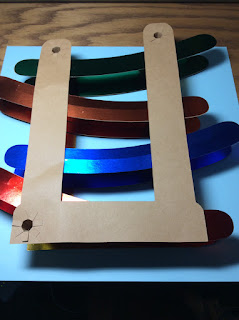Using the Physics of Motion to Flip an Object Over a Series of Parabolas
In my blog posting of Galileo's Parabolic Experiment - Part #1 https://papercraftetc.blogspot.com/2023/03/a-stem-project-galileos-parabolic.html, I demonstrated Galileo's theory of parabolic trajectory of projectiles. In this posting, I use that physics of motion to flip a object over a series of parabolas.
The object is two ball bearings that have been placed side by side with cardstock. I used black and white cardstock so that the movement of the object can be seen flipping from one parabola to another.
When the object is released from the highest parabola, it travels down the parabola and falls off of that parabola. The falling motion flips the object. The process of traversing and flipping the object is repeated for each parabola.
Here is a video which shows the movement of the object.
Here is the PDF. I used 65 lb. cardstock, Glue Dots and two 9 mm ball bearings.
Here is the .Studio file.
Here is the SVG. The file extends beyond the scope of the viewing field. Zoom out to see the entire file.
Glue the notched and unnotched sides of the parabolas together. Repeat for the other side.
Apply glue in the seam the notch. Insert the bed of the parabola.
Repeat for the other side.
Make the stand by making the dowels and glueing them to the sides. Using Glue Dots arrange the parabolas with the baffled side in the higher position.
Make the object with two colors of cardstock.
Glue the long strips into a circle at the tabs. Glue the circles to the center of each circle. Please note there are two sizes.
Glue the larger size to one side and the smaller size to the other side. Apply glue to the bottom edge as shown above.
Completed Ball Bearing object.










No comments:
Post a Comment